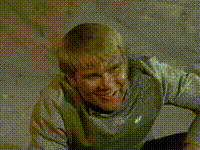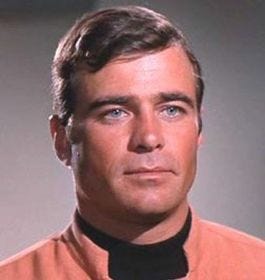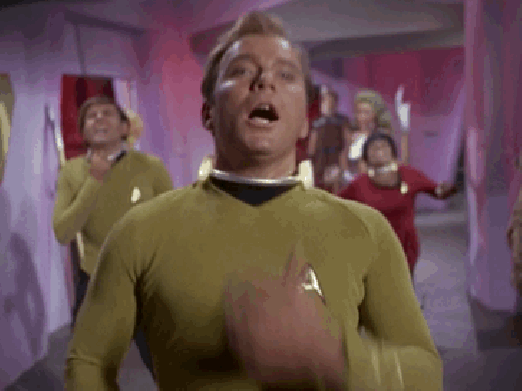Warped Drives
Six decades of Star Trek kinkery
This is rather embarrassing to admit, but I watched nine hours of the doc Center Seat: 55 Years of Star Trek. And there’s no Bill Shatner – probably they couldn’t afford his newly-minted sub-orbital astronaut ass.
As I’m really only a proper Trekkie – or so I like to tell myself – for the original highly Freudian 1960s series and its stellar buddy-love story of Kirk and Spock (and a jealous, bitchy Bones), I had planned to turn off once that era and the movie spin-offs had been covered. Perhaps it’s down to the way that streaming services automatically serve up the next episode, no matter that you’re asleep or dead, but despite the terrible title and the tacky, shopping-channel production values, I ended up watching all ten 47-minute episodes.
Yes, even the one about Deep Space 9.
Star Trek‘s ‘five-year’ mission has lasted a lifetime. My lifetime. So that you don’t have to, here are some titbits and ruminations on TV’s longest-running, fastest-moving, and most heavily made-up franchise:
Lucille Ball had great taste. The then head of Desilu studios, financed not one but two hugely costly pilots for Star Trek. She also made Mission Impossible (1966) – my other favourite TV show as a kid. Apparently, we both had expensive tastes: these were the two costliest per-episode TV shows of that era. So costly in fact that Ball ended up having to sell Desilu Studios to Paramount. Personally, I think it was totally worth it.
Gene Roddenberry, creator of the most successful TV series ever, set in a perfect, idealised future when war, want, money and toilets had been abolished, was, certainly in his later years, a complete, monstering, nightmare. On speed. He was a control freak, compelled to mark his territory by re-writing every single script – including rewrites of rewrites.
“AND HE WAS A BAD WRITER!!” complains Harold Livingston, the still-traumatised after all these years scriptwriter for Star Trek: The Motion Picture (1979), whose contract with Paramount specifically stated – at his insistence – that Roddenberry’s fidgety fingers wouldn’t be allowed to touch his script. Roddenberry of course couldn’t help himself: Livingston walked, was sweet-talked back by the studio, then walked again when Roddenberry kept fiddling.
Roddenberry though had every right to be impossible: for years he was swindled out of his share of the astronomic amount of dough his brainchild made in re-run fees.
Walter Koenig, who played Pavel Chekhov, the cute navigator in the Davy Jones wig and comedy Russian accent – now proudly bald and in his 80s – comes across as perhaps the most likable cast member from ToS. Perhaps not unrelatedly, he also looks like the one who made the least money.
When the great Ricardo Montalban returned to reprise his seminal 1960s ‘Space Seed’ role of Khan the evil Ubermensch megalomaniac in the 1982 movie The Wrath of Khan, everyone was in awe of the imposing bullfighter-bodybuilder-actor. So much so that no one, including the director Nicholas Meyer, knew what to say when he screamed all his lines at the top of his large lungs in his first shoot.
Eventually Meyer plucked up the courage to speak to him privately, nervously quoting Lawrence Olivier, saying, ‘“Never show the audience your top, because then they know you have no place to go.”’ There was a pause. “Ah! You are going to direct me! That is good. I need direction. I have no idea what I’m doing!”
The Next Generation (1987-94) was even duller than I remember it.
Jonathan Frakes, who played Riker, was the first bear in space.
Wil Wheaton, who played Wesley Crusher, is now – or whenever the interview they used here was made – a proud baby bear. With really bad tattoos.
Deep Space 9 (1993-99) was mostly make-up, foam rubber and panic. About the lack of viewers and air.
If you were playing an alien, you might have to spend four hours in the makeup department before shooting began. You would also not be able to go the toilet that didn’t exist in the Star Trek future without a ‘rest-room buddy’ to help you negotiate your costume and prosthetics. So everything has its upside.
Kate Mulgrew who played Captain Janeway on Voyager (1995-2001) didn’t exactly warm to Jeri Ryan (Seven of Nine). In fact, the atmosphere on set was colder than the rings of Uranus. It was, by all accounts, cosmically awkward. Maybe not so surprising, given that a stunning, younger, new crew member hijacked her ship and her show with her sprayed-on costume and Borg battery-powered charisma. Even worse, Ryan turned out to be a great actor.
More surprising was learning from Tim Russ, who played Science Officer Tuvok, that he was also hurt, in an entirely professional and not at all insecure fashion – because he felt his logical Vulcan style was being cramped by the Borg lady. With the huge bazookas.
I didn’t miss anything by skipping Enterprise (2001-05) altogether. Nor did you.
Several of the actors from Enterprise now look older than actors from Voyager or even TNG. The radiation-screening on prequel starships must have been dangerously primitive.
Oh, and the Talosians, the wonderful aliens in that very pricey first pilot ‘The Cage’ – the ones who looked like Quentin Crisp, but with large, indecently veiny hairless spherical heads – were actually women actors with male voices dubbed over. The network rejected the pilot on the basis that it was ‘too cerebral’.
Which, I guess, is one way of spelling ‘testicle’.
Naturally, this is all just a transparent pretext-preamble for me to write about the fact that I recently rewatched, for the first time in decades, all three seasons of Star Trek: TOS, remastered to look fantastically crisp and colourful. Sometimes you can see the paintwork on the (wooden) doors for the turbolift. Along with the dirty fingerprints.
I also noticed lots of other ‘dirt’ that I hadn’t see before – or had forgotten. Or repressed. And I honestly thought that I had squeezed every ounce of subtext out of Star Trek in my essay ‘Captain Kirk’s Bulging Trousers’, published twenty years ago, when the franchise was ‘only’ three decades old.
But I was wrong. So wrong.
‘The Cage’
The original pilot from 1965, with Hollywood star Jeffrey Hunter as captain of The USS Enterprise, held in a Perspex dungeon by bollock-headed Quentin Crisp aliens who want to see him mate.
I share their voyeuristic interest, but we’re very lucky that NBC passed on this pilot, and he lost interest by the time the second (successful) pilot was commissioned – with William Shatner taking command as Captain James T. Kirk.
Dishy as Hunter was, he has none of Bill’s twinkly-eyed seductive charm – or stagey tricks for keeping our eyes on him. He’s also far too… American. Shatner was, and remains to this day, Canadian. Slightly swishy Canadian. The way he runs. The way he crosses his legs. The way he points his sideburns.
All-American, square-cut Hunter would have bored us to death before we left orbit.
Also noteworthy is the way the uniforms got a lot tighter and thinner when the show was commissioned. The ones in the pilot are 1950s shapeless rather than 1960s sexy.
‘The Ultimate Computer’
M5, a fiendishly clever new Federation mega-computer, threatens to put Captain Kirk out of a job – and emasculate him.
I think we all know how that feels now.
But it was this remarkably explicit scene that leapt out at me and covered me in goosebumps. Spock the computer nerd has, until this point, apparently been all eyes for M5 and its dashing creator, the tall, handsome (and black) genius, Dr Daystrom (William Marshall). Tiny Jim has been feeling forgotten and decidedly forlorn. His First Officer suddenly, and powerfully reassures him of his indispensability – as well as his desirability, and masterfulness:
“[The M5 is] Practical Captain, perhaps. But not desirable. Computers make excellent and efficient servants. But I have no wish to serve under them. Captain, a Starship also runs on loyalty. To one man. And nothing can replace it. Or HIM.”
Jim’s grin at the end of Spock’s speech is essentially a big sloppy French kiss.
‘Shore Leave’
The one where they beam down to a planet that manufactures whatever it is the crew members are thinking of. A bit like Pornhub.
Bones gets a giant white rabbit and Alice. Sulu a Samurai warrior.
Kirk is served up two people from his psycho-sexual past. A dull young woman called ‘Ruth’ with pretzeled hair (who is accompanied by cheesy ‘love’ music), and a much prettier, livelier young Irish man called ‘Finnegan’ (accompanied by cheeky Irish jig music), who calls Kirk “Jim baby!”, beckoning him on with a toothy grin and tongue licks.
Apparently, he gave Kirk a hard time when he was a plebe at Starfleet Academy, a decade-or-so ago. Kirk hasn’t been able to stop thinking about him ever since.
Kirk ends up sweaty, exhausted, his tunic strategically torn and sporting a satisfied grin.
(Finnegan’s middle-aged stunt double in a wig clearly had fun too.)
Kirk’s swishy running is an added bonus.
‘The Enemy Within’
I’d completely forgotten about how brilliant this episode is, dramatically and psychologically. Kirk is split into two personalities by a transporter malfunction: Nasty Top and Needy Bottom.
As he says:
“I have to take him back inside myself. I can’t survive without him. I don’t want to take him back. He’s like an animal, a thoughtless, brutal animal….”
I have a hunch this is also one of Mr Shatner’s favourite episodes. After all, he’s both the star and the main guest star.
Metamorphosis’
Meet Zefram Cochrane, a 237-year-old man, abducted 150 years ago by a flying alien electrical vagina called ‘The Companion’.
Kirk & Co. discover him on an unknown planetoid – after being abducted themselves to keep him company.
You can see why The Companion, who calls him ‘The Man’, was so keen on wrapping herself around him for so long – and why she restored his youth, keeping him ageless and, er, erect.
However, if she was a gay man into muscle twinks, she might have used her rejuvenating powers even more. Glenn Corbett, the actor playing Cochrane, was a model for the famous underground gay photographer-pornographer Bob Mizer before Hollywood snapped him up. Probably when he was serving in the US Navy.
‘The Gamesters of Triskelion’
Strong suburban fetish party vibe. Kirk, Chekhov, and Uhuru are held captive in pink cells by a ‘Thrall Master’ who is going to ‘train’ them – with the aid of harnesses and a ‘Collar of Obedience’.
Watching again, I discovered I had forgotten almost everything about this episode, apart from the Collar of Obedience, and how the aesthetics seem to have been inspirational for Toyah Willcox. Oh, and Nichelle Nichols fantastic flair for over-acting that competes even with Mr Shatner’s (note how her collar activates a full two seconds after everyone else’s, and causes her to wave her hand in the air, when everyone else is clutching at their throats).
And I had most particularly forgotten about the scene where Chekhov meets his ‘Drill Thrall’ (This clip is dubbed, but pretty accurately):
‘Mirror Mirror’
‘Indubitably’ one of the campiest TOS episodes. Which is really saying something.
It has:
Sashes.
Spock in an Emperor Ming beard.
Kirk’s glittery tank-top heavage.
Uhuru in a crop top, with dagger accessory.
Sulu as scheming Chief of Secret Police.
The Captain’s Woman.
Assassination plots.
Pain booths.
Chekhov’s wig.
‘Mirror, Mirror’ is less of a tale of fascism vs democracy – or neoliberalism vs social democracy – than a satirical commentary on the show itself and its sexual aesthetics. The ISS Enterprise is the somehow even more Freudian version of the USS Enterprise.
Much of the first season of Star Trek: Discovery drew heavily on this episode – probably because the regular trips to the Fashy Dark Side were a very welcome relief from the woke tedium of that show.
But in both worlds depicted in ‘Mirror, Mirror’ one thing remains constant and unchanged: Spock’s love for Kirk. Even in the dog-eat-dog, cutthroat, mirror universe, where promotion can only happen by assassination, Spock is even more dedicated to his Captain than… the Captain’s Woman.
‘Requiem for Methuselah’
At the end of this episode, towards the end of the third and final season, Kirk is heartbroken, having lost a glamorous highly convincing female android he fell madly in love with – and who, of course, fell even more madly in love with him (causing her terminal malfunction). McCoy delivers a speech to Spock that seems cruel and gloating:
“You see, I feel sorrier for you than I do for him because you’ll never know the things that love can drive a man to. The ecstasies, the miseries…. All of these things you’ll never know simply because the word love isn’t written into your book.”
But of course, Spock loves Kirk even more than McCoy does. McCoy knows this, and probably intended to provoke Spock to use his ‘forget her!’ mind-meld power on the love-sick Captain.
So they can go back to their space-travelling, merry male love-triangle.
‘Turnabout Intruder’
This controversial final-ever episode of TOS (June, 1969), is about a woman, Dr Janice Lester (Sandra Smith), who definitely hasn’t forgotten James T. Kirk. And is out for revenge.
I have no recollection of seeing it before at all. So I can only imagine the visceral horror that this episode caused me as a small boy when it reached the UK in the early 1970s – and the trauma that induced me to completely repress the memory of it. The lovely phallic world of male technological mastery, order, and camaraderie, intruded by a vengeful, jilted, cunning woman intent on taking command of the Enterprise!
Even worse, she ‘intrudes’ into the masculine body of Kirk himself. Taking command of those twinkly eyes, that masterful chin, and those bulging trousers. As Scotty – it would be Scotty – puts it to Bones, his face a picture of Caledonian horror and confusion:
“Doctor, I’ve seen the captain feverish, sick, drunk, delirious, terrified, overjoyed, boiling mad… but up to now, I have never seen him red-faced with hysteria.”
But perhaps it was the outrageous campiness of Shatner’s interpretation of a man’s body possessed by a woman that really horrified him.


















